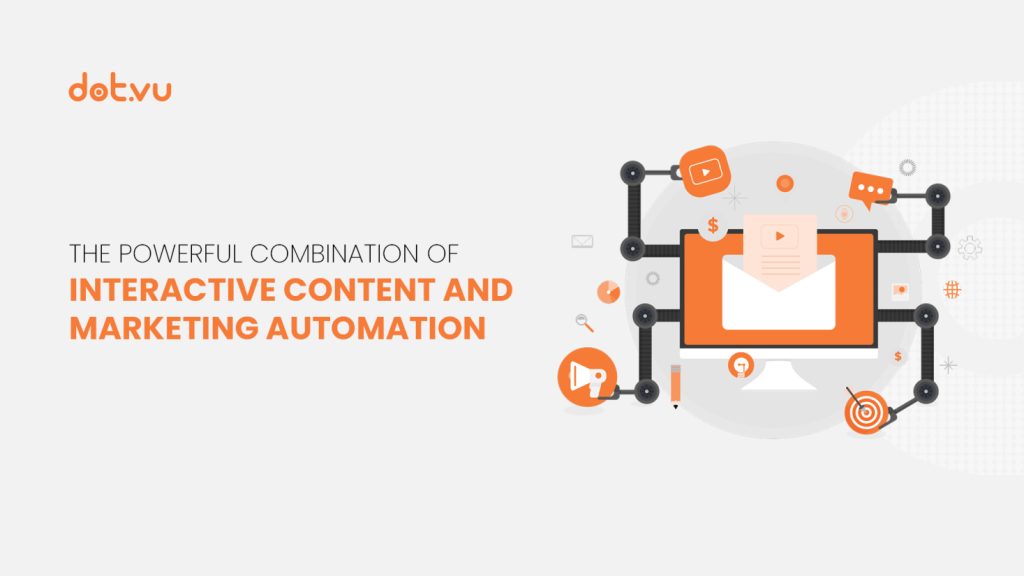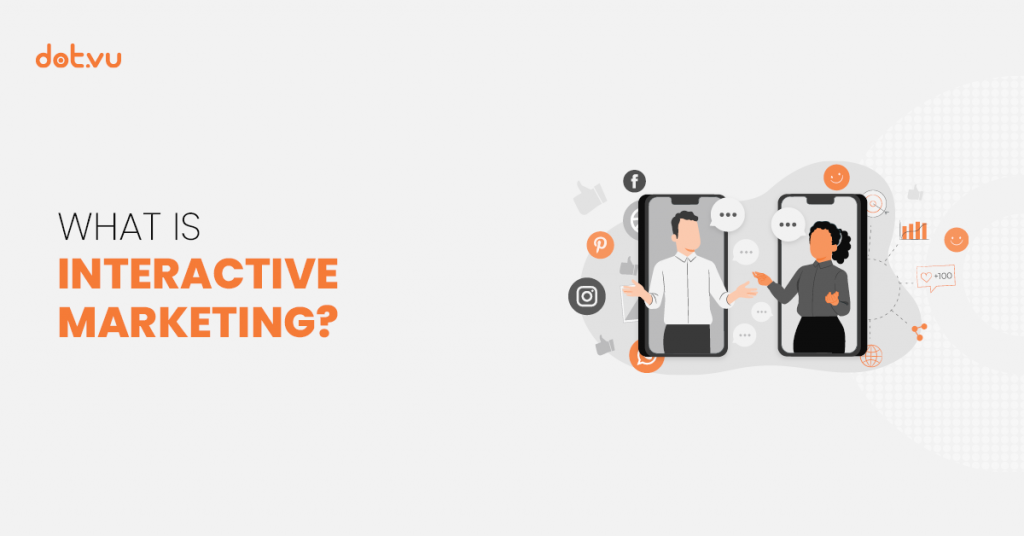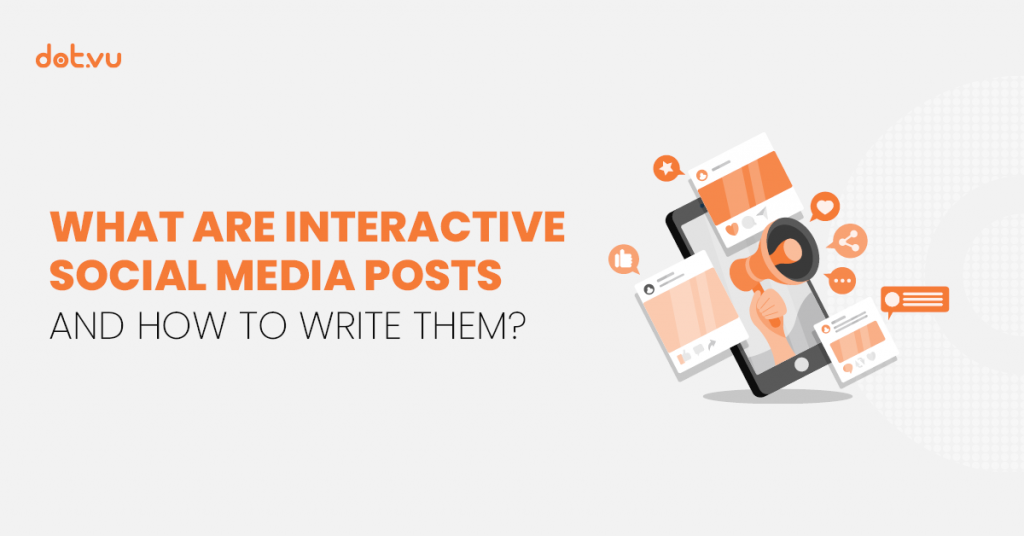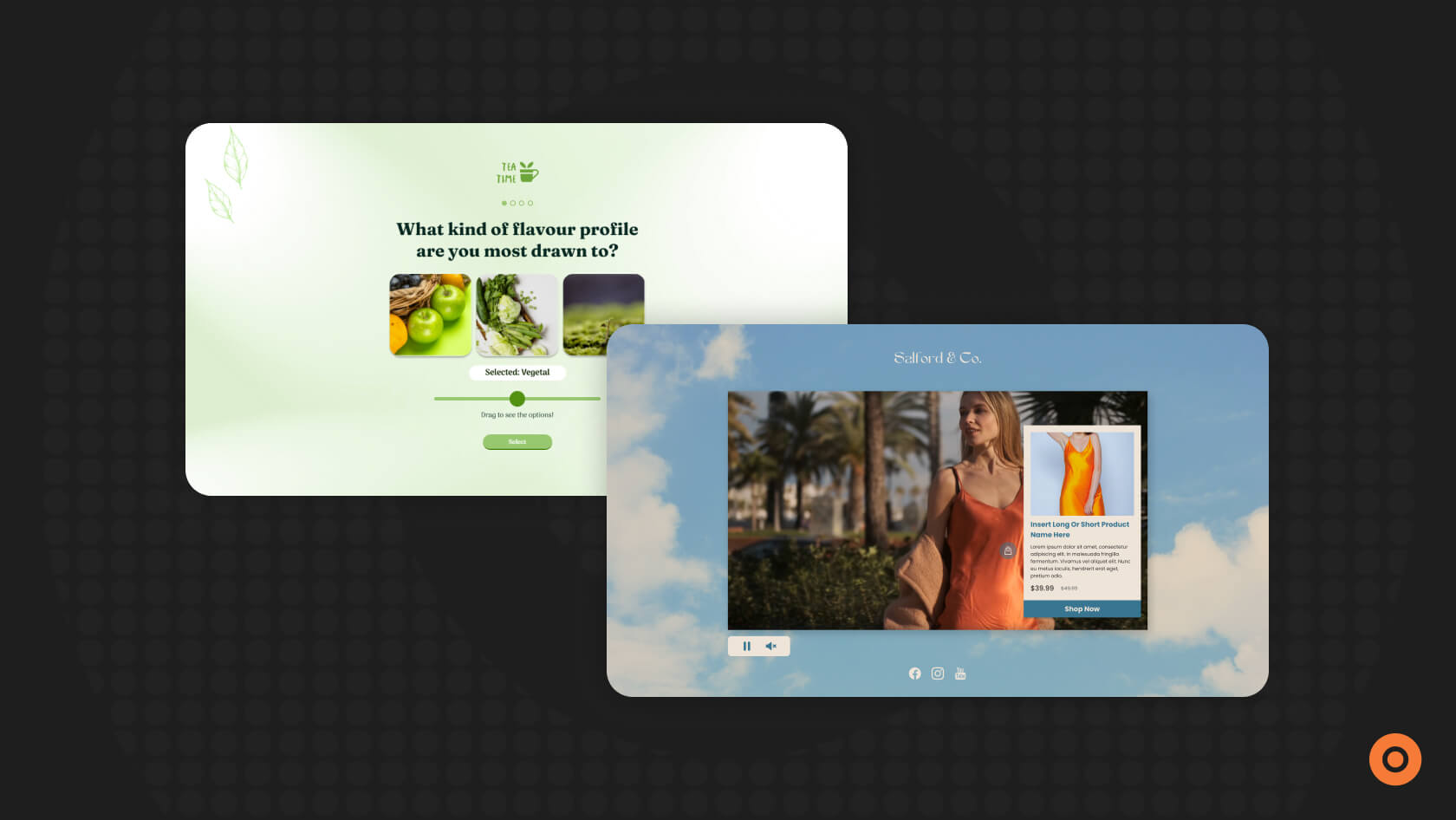
Interactive Content has rapidly evolved from an emerging concept to a cornerstone of modern marketing, fundamentally changing how companies engage with their audience. Recent research reveals a striking 94% higher engagement for companies using Interactive Content compared to those relying on static content. As a leading martech trend in 2023, the rise of Interactive Content can be attributed to different factors and key events.
Netflix’s foray into interactive TV shows and movies has played a pivotal role, capturing viewers’ imaginations worldwide. The COVID-19 crisis further accelerated this trend, compelling companies to innovate in capturing their audience’s attention during lockdowns. Interactive Content emerged as a powerful tool in this quest. Furthermore, Google’s emphasis on page experience in its May 2020 update, prioritizing the interactivity of a page in website rankings, has underscored its significance.
As Interactive Content’s popularity soars, it’s time to delve into this revolutionary approach. This beginner’s guide will unveil what Interactive Content is and how it’s reshaping the digital landscape. Join us as we explore the world of Interactive Content, where engagement and innovation meet.
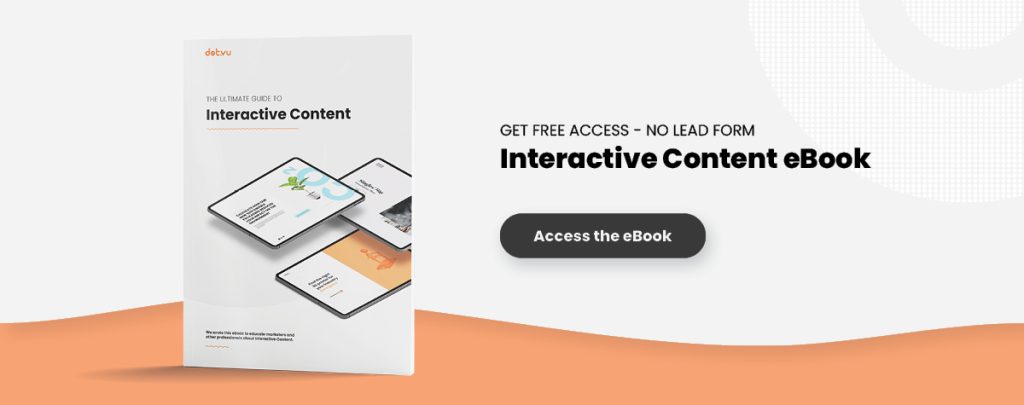
What is Interactive Content?
Interactive Content is a type of online content where the audience plays a central and active role in the experience. In other words, rather than passively consuming a piece of content, the audience is asked to interact with it by answering questions in a quiz, choosing their own journey in a video, collecting points in a game, and so on.
The goal of Interactive Content is to create personalized and memorable experiences for the viewers, and that’s why lots of companies are adding Interactive Content to their marketing strategies. Indeed, adding Interactive Content to your marketing strategy can increase your chances of capturing your customers’ attention and making them engage with your content.
Interactive Content is content that requires active engagement from the audience. More than passively reading, watching, or listening, the audience is required to actively participate and become an integral part of a dynamic, two-way experience.
Interactive Content Definition
Do you need to use more Interactive Content? Find out in this assessment:
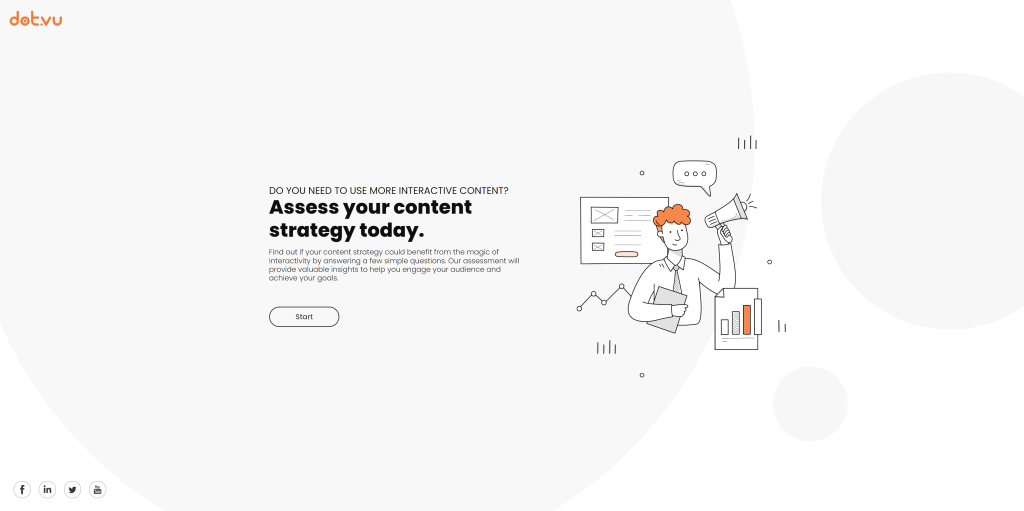
What is the difference between Content Marketing and Interactive Content?
Interactive Content and Content Marketing are not opposed or separate from each other. On the contrary, Interactive Content should be considered a part of your Content Marketing Strategy and should be added to your Content Marketing Funnel. In the following image, you can find ideas on how to create buyer’s journey content for each stage of your Content Marketing Funnel:
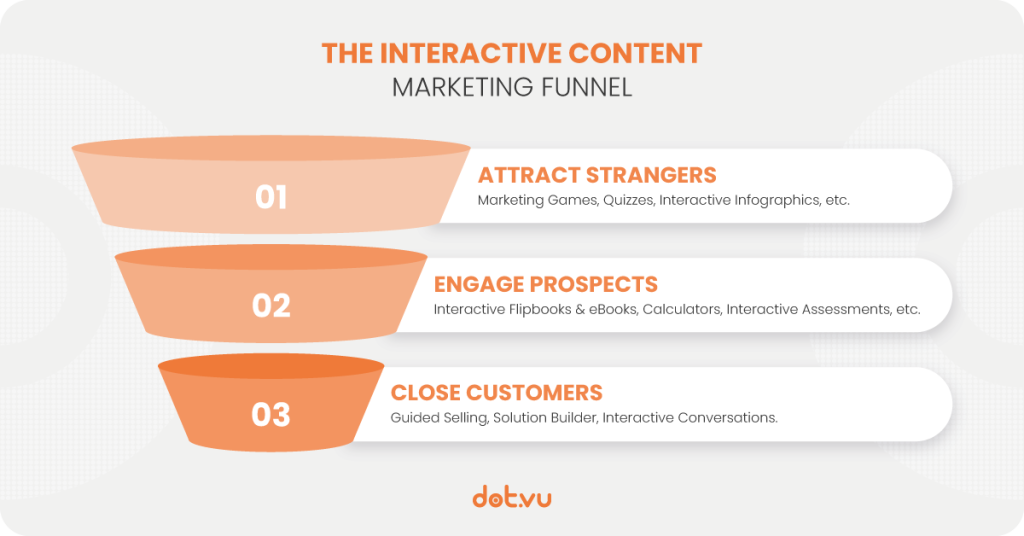
What are the main benefits of Interactive Content?
There are many different benefits of using Interactive Content depending on which types of Interactive Experiences you go with. Nonetheless, let’s review the main benefits of Interactive Content that apply to most types.
1. Attract Potential Customers
As a marketer, it is getting harder to gain your customers’ attention. This can be reasoned by the fact that the attention span of human beings continues to decrease. A study, by Microsoft Corp, showed that customers already have a lower attention span than a goldfish! Thus, website visitors often leave a webpage after only 10 to 20 seconds. That is an incredibly short time to catch someone’s attention. But, did you know that Interactive Content generates up to 5 times more views than static content? That’s because Interactive Content is made to be eye-catching and engaging. Thus, it helps you get the attention of even the most difficult to attract goldfish.
2. Improve User Experience
The concept of Interactive Content is linked with the concept of user experience. Why? Simply because Interactive Content creates a better user experience! In an Interactive Experience, the user experience adapts to the user, thereby making it more relevant to them. Did you know that over 88% of online shoppers say they wouldn’t go back to a website after having a bad user experience? That’s why Interactive Content is so crucial these days! Because it is a simple way to make sure to improve user experience and ensure you won’t lose any potential customers.
3. Increase Engagement
Over 58% of Marketers think their content does not increase engagement! That’s quite high, mostly when knowing that Content Marketing is one of the main focuses of Digital Marketers nowadays. However, 70% of marketers think that Interactive Content is efficient at engaging visitors and buyers. Therefore, Interactive Content is better at engaging users than static content. It’s not surprising at all, because creating Interactive Experiences encourages visitors to participate actively. In other words, they are designed to be engaging.
What Is Interactive Co“56% of marketers believe that their content does not increase engagement, but 70% of them believe Interactive Content is efficient at engaging visitors. Thus, Interactive Content > Static Content” Share on X
4. Educate Potential Customers
Another important benefit of Interactive Content is that it’s great at educating potential customers. Indeed, 93% of marketers believe that Interactive Content is effective at educating buyers. You can use different types of Interactive Content such as Quizzes, Interactive Flipbooks, Interactive Assessments, Interactive Calculators, Guided Selling experiences, etc., to educate customers about your products, your company, your values, and so on. Educating customers can help you convert website visitors into confident buyers. Moreover, buyers appreciate brands that provide educational and inspirational content.
5. Generate Qualified Leads
Did you know that Content Marketing generates 3X more leads than outbound marketing practices for 62% of the cost? Knowing that Interactive Content is simply a better type of content than static content because it is designed to be more engaging and interactive. We can safely extrapolate and say that this means Interactive Content generates even better-qualified leads than regular types of content. Thus, it’s one of the best ways to boost your lead generation strategy.
6. Boost Sales
We just discussed how Interactive Content is one of the best ways to boost your lead generation strategy. Once you have gained these leads, you can use Interactive Content to convert them into confident buyers. For example, there are many types of Interactive Experiences that are specially designed to boost sales for both B2B and B2C companies. Just to name a few, there are Guided Selling experiences, Interactive Conversations, Product Catalogs, Interactive Shopping Videos, and so on.
7. Collect valuable customer data
With an Interactive Content platform such as Dot.vu, it is easy to collect data on every touchpoint of the customer’s experience. Meaning that, every time a customer answers a question in a quiz, participates in a Marketing Game, or finds out which products best fit his need in a Guided Selling experience, you collect that Zero & First-Party data in your CRM system. This allows you to know your potential and active customers better and personalize your marketing efforts. You can also unleash the potential of hyper-personalization marketing with the help of Interactive Content.
8. Differentiate your content from competitors
According to HubSpot, writing content was the top focus area of most marketers in 2019. This means it is becoming increasingly difficult to create content pieces that are original, valuable, needed, and that rank well on Google. One of the best solutions is Interactive Content. Indeed, 88% of Marketers believe that Interactive Content differentiates them from competitors. By creating content pieces that put the customers first and engage them in a fun and creative way, marketers can catch their attention because they are doing something more original. Hence, they succeed in differentiating themselves from competitors.
9. Enhance Brand Loyalty
Finally, Interactive Content is great to enhance brand loyalty. Why? Because Interactive Content allows you to understand your customers better through data collection. Thus, you can adapt your product offerings to their needs. Plus, Interactive Content helps you deliver a better and more engaging user experience that is different from competitors. All these reasons are why customers will come back to you and become loyal.
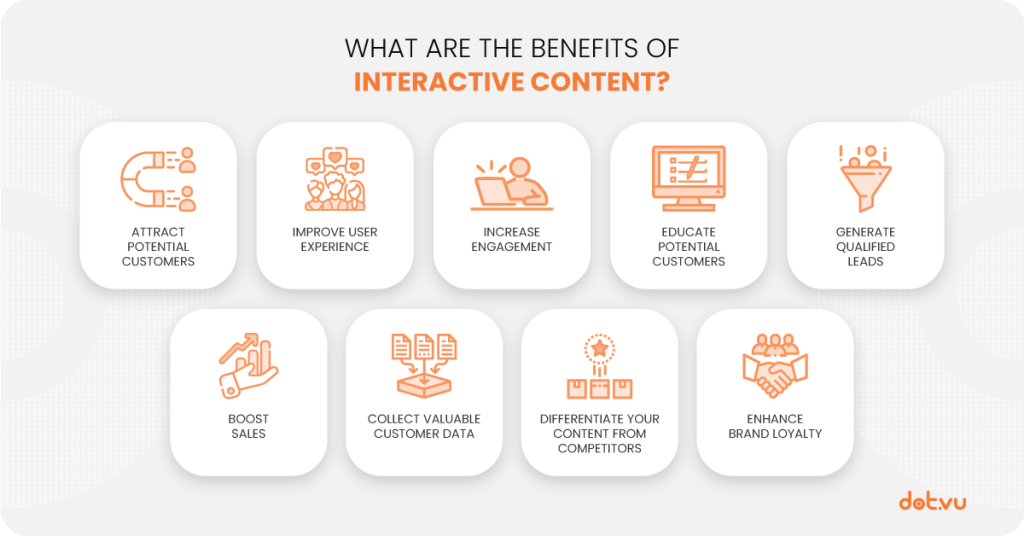
How to get started with creating Interactive Content?
There are 2 ways of getting started with Interactive Content. The fastest and most cost-effective way to get started would be to repurpose static content. into Interactive Content. The other way to get started would be to go all-in and create Interactive Experiences from scratch.
Repurpose Content
Did you know that 86% of businesses are looking into repurposing content in the next few months? Interactive Content is one of the best ways to refresh your content because it will help you create content that is more engaging and that converts better. Moreover, Interactive Content is never static, meaning that you can always modify it when needed. For example, if you spot a grammar mistake or want to update the statistics in your content for a new year, you can modify your Interactive Experience in no time. A lot of other types of content such as Images, Infographics, and PDFs are static, and you don’t have control over them once they are shared.
Pro Tip: Take a look at our blogpost on 20 ways to repurpose your content into Interactive Experiences
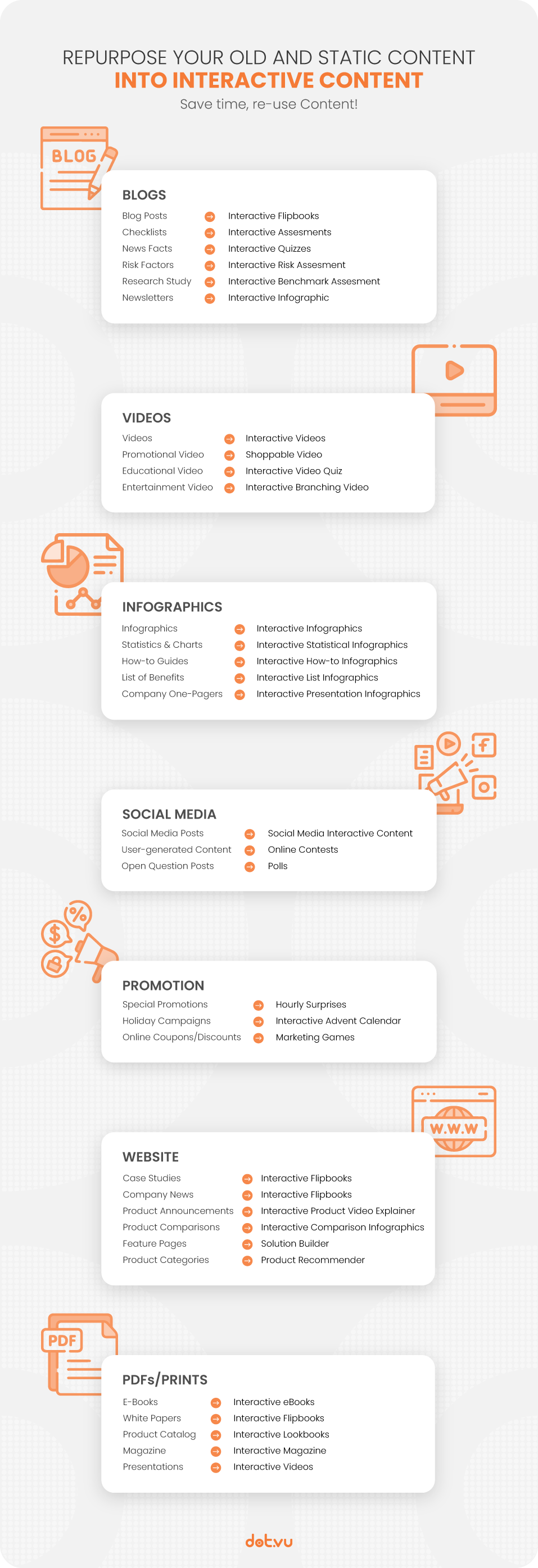
From Scratch
Another idea could be to start from scratch rather than repurposing content. You can begin by thinking about your Content Marketing Funnel. What sections of your funnel do not work as well as the others? That’s where you should think about adding one or more Interactive Experiences to boost effectiveness. For example, you could be getting lots of traffic on your blog, but you have a hard time converting that traffic into leads. By creating gated downloadable Interactive Flipbooks that are valuable for your blog visitors, you will be able to convert more visitors into leads.
What makes an effective Interactive Experience
1. Strategy
Interactive Content requires a lot of strategic thinking in advance, compared to static content. Before you start creating, you must be clear about the target audience, your overall objectives, and what you want the specific results to be.
- Objectives and KPIs
Having effective Interactive Content requires specific objectives in mind. Are you planning to generate awareness, create more leads or just educate your customers? Based on that, you can decide upon the right type of Interactive Content and set up relevant KPIs such as traffic, conversion rate, interactions, etc. That will help track the analytics of your campaign’s effectiveness. Moreover, it will help you to take full advantage of data, optimize and personalize your future content.
- Target Audience
Good content is written for a specific audience. Thus, ask yourself the question: Who is your key target audience? To have effective Interactive Content, you must know whom you are creating it for. Helping to set up clear objectives, as mentioned before, can determine whom you are targeting. Thus, you can improve your key messaging, which resonates with the audience and will help you reach your goals more effectively.
2. Content
Furthermore, engaging content is a big part of an effective Interactive Experience. Beyond just design, there goes overall structure, feel, and layout to it. Effective, compelling content includes a clear call-to-action (CTA) and is search engine friendly. Most of all, the content is valuable to the user.
- Design and layout
Having a straightforward, minimalistic design is essential for customers to perceive your content more easily. Thus, the layout should be intuitive. A good Interactive Content Experience drives more leads than static content. In turn, consider the placement of the lead form within your Interactive Experience to collect more information. Based on your objectives, it might make sense to place it at the beginning or end. After all, make sure you have a coherent flow throughout the whole experience, and it does not lose its message.

- Effective Interactive Content
An effective Interactive Experience is only effective when you utilize it to the fullest with SEO and CTAs. So, make sure your content has the right keyword phrases inserted and has ALT-text for all of your graphics and videos. Integrate buttons with a clear call to action to create more leads, for instance, “buy now” or “book a demo.” A strong, simple, and clear call to action should be included at the end of your content, directing users to the next steps you want them to take.
- Valuable Content
Good content provides value. Thus, to have the most effective content, make sure it brings value to your customer and is engaging and fun. Think of what’s in it for your customers? What benefit will they receive from interacting with your content? Those are the questions that you should consider during content creation. Engaging content performs better and gets more leads. Hence, make sure that the content is interactive and valuable for you and your customer!
3. Marketing
Your Interactive Experience will not perform well on its own. Therefore, it is essential to have a promotion strategy on which channels you will promote it.
- Promotion
One of the communication channels, which requires the least resources, are social media platforms. Set up posts on your LinkedIn, Twitter, or/and Facebook channels to reach more people. In addition, you can send an email newsletter about your new exciting experience. Also, set up ads for an even higher conversion rate. Properly distributed and promoted content will make your Interactive Experience even more effective. Do not miss out on some key opportunities to connect with your audience. Remember to engage with your audience and use social listening tools to get insights into your customers’ talk. Create UGC (User Generated Content) campaign where your customers become your advocates and share the news themselves. It’s not enough to distribute content across the online channels and leave it at that, hoping for the best. The most successful brands actively engage with their followers, creating two-way conversations that encourage questions, comments, and shares.
- Automation
When you connect marketing automation platforms such as HubSpot, Pardot, Marketo to your Interactive Experience, you have a new level of personalization available to customize your email flow. You can tailor your message and use additional content to what you know that your customers particularly want. You will also be able to collect more detailed information from each person. As a result, you will refine your buyer personas and create specifically tailored content for them.
Tips when doing Interactive Content
Writing Interactive Content is quite like writing other types of Marketing Content. So, you can follow the same tips & tricks as you used to. But, the following tips are particularly important for Interactive Content production:
1. Start simply
There are many different types of interactive content, but you don’t have to try them all at once! A good place to start is with simple Interactive Experiences such as Quizzes, Marketing Games, or Product Recommenders. Later, you can try more complicated ones, like Interactive Videos or Interactive Virtual Tours.
2. Use an Interactive Content platform
To maximize the ROI of your Interactive Content think about getting an annual subscription to an Interactive Content platform. For example, on Dot.vu—recognized as a top Interactive Content Platform by Business Research Insights—offers over 200 ready-to-customize templates. This means that you can create many Interactive Experiences in no time and without writing a single line of code.
3. Keep it brief
People have short attention spans, so try to keep the content as short as possible. It’s better to keep the user’s undivided attention for a short time than intermittently for a longer time.
4. Motivates participation
It is important to work on how you can motivate your audience to actively participate in your Interactive Experiences. There are many ways to incentivize participation. For example, direct feedback after a Quiz or an Assessment is one way. Another way could be the possibility to win discount codes or free products.
5. Make it visually appealing
Did you know that 48% of users believe website design is the #1 factor to judge the credibility of a business? That’s why it’s so important to create Interactive Experiences that are as visually appealing as possible.
Pro Tip: Don’t design overcrowded Interactive Experiences. A minimalist approach is best!
6. Make it engaging
Think about the content you are creating from the user’s point of view. Make sure it’s fun, engaging, enlightening, and easy to consume!
7. Consider Gating your content
Follow the gated content best practices and reflect on which type of content you should gate. For example, you could gate the result of your Interactive Assessments to collect insightful data and grow your email list.
8. Gather Valuable Data
Interactive content marketing is not just meant to engage your audience. It is also meant to collect valuable data. Every click, action, and answer can be registered in your database. Over time you will be able to build rich lead profiles.
9. Personalize your marketing efforts
You can use the data you collect and your newly built rich lead profiles to personalize your marketing tactics. For example, if you create a personality test, you can divide participants into four personality groups. This means you can send four different emails, each targeted specifically to one of the groups. More personalized marketing means better results!
10. Promote your Interactive Experiences
If you want to ensure the success of your Interactive Experiences, you must promote them well. Don’t hesitate, share them through Interactive Social Media posts, in your Email Newsletters, or even think about promoting them with Paid Ads.
Related article: How to promote your Interactive Content to boost results?
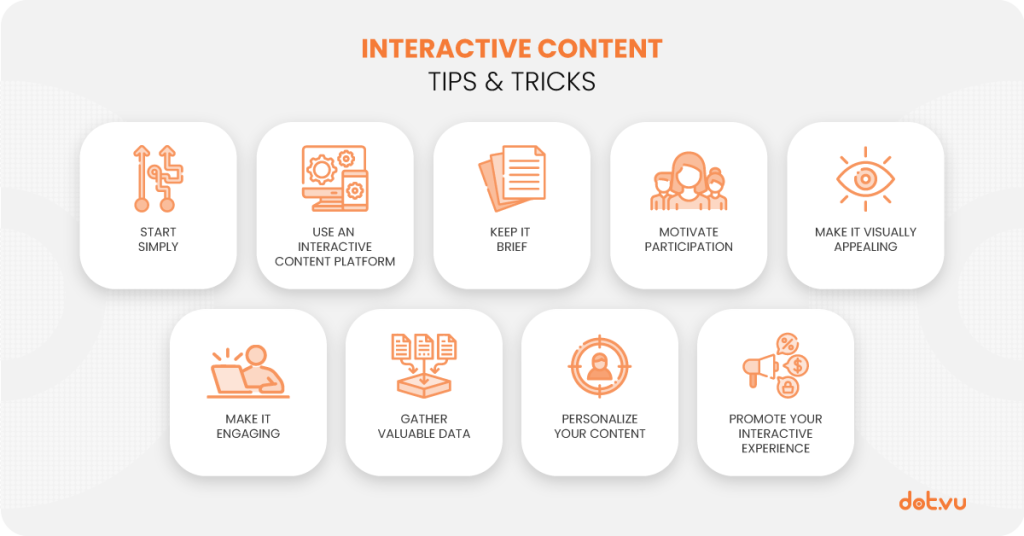
13 Types of Interactive Content
There are many different types of Interactive Content. Below we will introduce the 12 most popular ones. Because an example is worth 1000 words, under each type, you’ll find an example. All examples are ready-to-customized templates available on Dot.vu’s MarketPlace.
1. Guided Selling
In a Guided Selling experience, visitors will answer different questions regarding their needs, preferences, personality traits, and so on. Once the questionnaire is completed, they will be presented with the best solutions, products or services that fit their answers. Guided Selling experiences are great to boost sales and enhance customer satisfaction.

2. Interactive Flipbooks
An Interactive Flipbook is a digital piece of content that resembles a physical book. Viewers flip through the pages of the flipbook directly on your website. It is a new and innovative way of presenting content that replaces PDFs and other types of paper-based content like magazines, reports and brochures or catalogs, etc. Another great functionality of Interactive Flipbooks is that you can embed other Interactive Experiences directly in them, for example, Marketing Games, Quizzes, Polls, etc.

3. Marketing Games
Marketing Games are mini-games used by companies to attract new customers, engage their audience, promote their products, and generate new leads. There are many different types of Marketing Games to choose from, like puzzles, wheel of fortune, spot the difference games, and many more. You can incentivize participation in your marketing games with leaderboards and the possibility to win prizes.

4. Interactive Infographics
What is an Interactive Infographic? An Interactive Infographic is similar to a regular infographic, the main difference is that they are much more engaging because they contain interactive elements such as hotspots, polls, surveys, quizzes, interactive videos, animations, and more. Therefore, as with any other type of Interactive Content, the viewers can actively engage with the infographic through the interactive elements instead of passively reading it.

5. Interactive Quizzes
In an Interactive Quiz, participants answer a few multiple-choice questions to score as high as possible. There are many types of marketing quizzes out there. Traditional quizzes have been used for a long time to test people’s knowledge on a specific topic. But, nowadays, online quizzes can have many different purposes. For example, you could create Branding Quizzes, Lead Quizzes, Promotional Quizzes, and so on.

6. Interactive Videos
An Interactive Video is much more exciting than a traditional video. The big difference is that an Interactive Video allows viewers to participate in the story and engage with it. For example, in Interactive Branching Videos, viewers can change the ending of the story or decide what happens next. In a Shopping Video, viewers can click on the items they are interested in to learn more about them, and directly add the items to their basket.

7. Interactive Virtual Tours
Interactive Virtual Tours are virtual tours that are improved by adding Interactive Elements to them. With Interactive Virtual Tours, visitors can take an active part in exploring the location. There are many different Interactive Experiences you can add to your Interactive Virtual Tours such as Marketing Games, Quizzes, or hotspots.

8. Online Advent Calendars
An Online Advent Calendar is a type of Interactive Content where visitors can come back to your website every day in December to unlock new games or surprises. So, instead of having a physical advent calendar, users will have access to their advent calendar online on your website. Consequently, they’ll go to your website to open a new door every day and discover their daily surprises. Interactive Advent Calendars are amazing for improving traffic, bounce rate, time on page, and so on.

9. Online Contests
Interactive Contests, by definition, are Interactive Experiences that encourage participation in exchange for a chance to win a prize. The idea of giving your customers a prize for spending time on your site shows your appreciation for your customers. Online Contests will not only encourage customers to stay on your site longer, but they will also create a positive feeling for your brand.

10. Social Interactive Content
With Social Interactive Content, you are essentially merging Interactive Content with a social dimension that requires customers to share the experience with their friends – much like referral marketing. The focus here is really on encouraging visitors to create their own content and share it with their family and friends. For example, for your next Mother’s Day Campaign, you could encourage visitors to write personalized letters to their moms.

Similarly, you could also engage your audience to write birthday wishes to their loved ones. This approach not only creates a memorable and enjoyable experience for the recipient but also helps to build a deeper connection between customers and your brand. By facilitating these personal interactions, you can demonstrate that your brand values individuality and fosters meaningful relationships with customers.

11. Interactive Calculators
Interactive Calculators are online tools that require visitors to insert data into a form in order to get an instant calculated answer. It is custom formulas decided by you that gives the answers. Interactive Calculators can help your customers to look at their financial stability when buying a house, create a budget, lose weight, and so on.
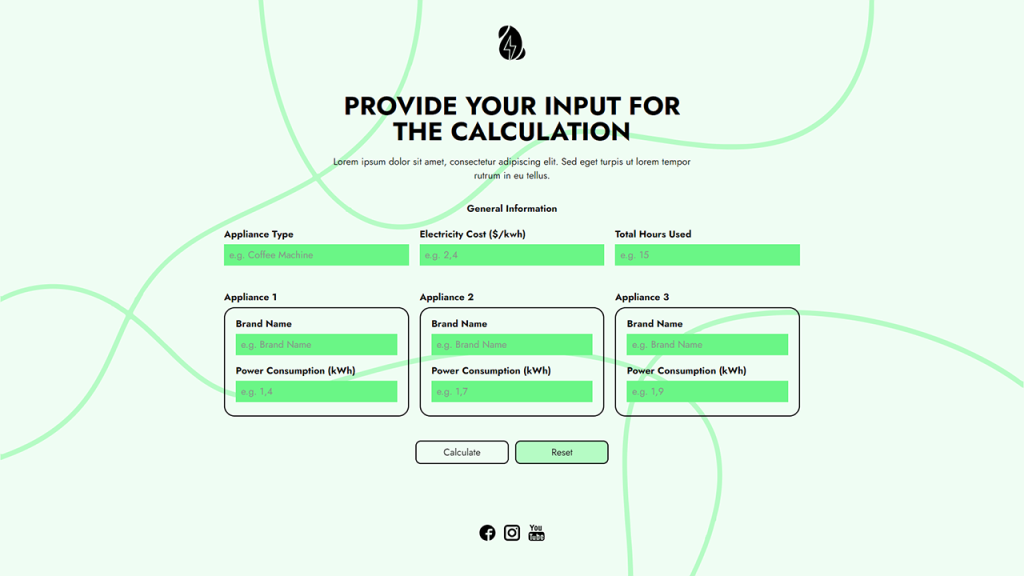
12. Interactive Conversations
An Interactive Conversation is a real-time, two-way exchange of information that helps your customers make decisions. Moreover, it helps your company capture, qualify and connect with your leads. With an interactive conversation, your leads no longer have to wait for your company to contact them back with answers to their questions. Instead, they can engage with your company when it’s convenient for them, 24/7, 365! To sum up, Interactive Conversations are great to improve and automate customer service and save time for your sales team.
Regarding Interactive Conversions, it’s worth mentioning that they are incredibly successful. However, they require lots of time and resources to create the animations and the voices needed for the experience. Therefore, it can’t be done by simply choosing a template and it is usually 100% custom made.

13. Personality Test
A Personality Test asks the user a set of questions about themselves and then assigns their personal traits, preferences, needs, and pain points to a specific personality type or product solution. Personality Tests are great to engage your audience on Social Media and grow your email list. Plus, they are amazing to learn more about your audience.
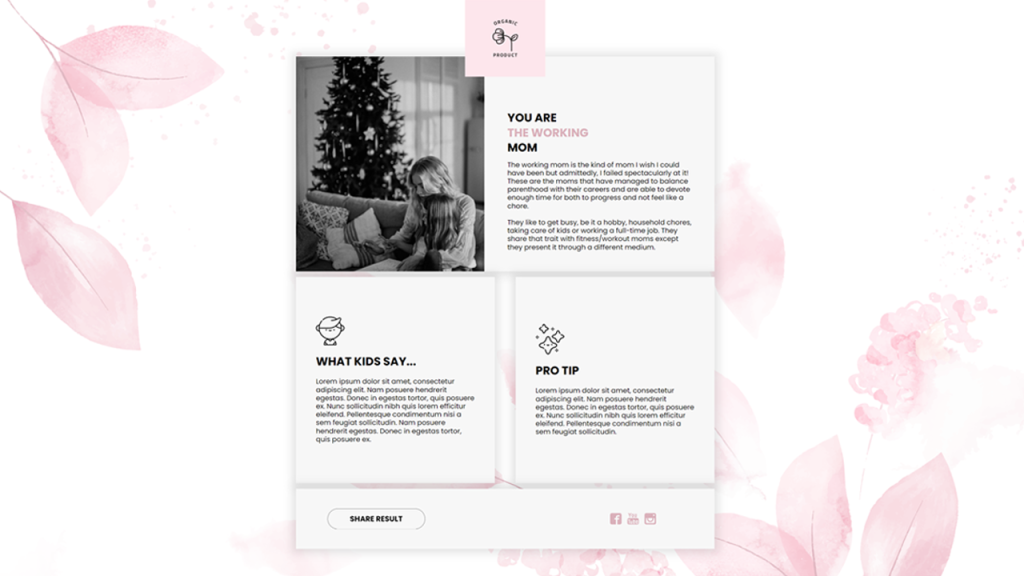
5 Successful Interactive Content examples from known brands
Now that you are familiar with what Interactive Content is, let’s show you 5 examples of Interactive Content campaigns that were very successful!
1. Benefit San Francisco
Benefit San Fransisco created and launched a branded Advent Calendar with 24 daily locks to activate their audience and generate new subscribers. The campaign was created in under 1 week, and it was published in 11 countries across Europe. It was a very successful campaign with over half a million hits and over 75K subscribers with it.

2. Callebaut
Callebaut designed a fun Scratch & Win Marketing Game to attract and entertain customers during a big food fair. Customers were invited to try their luck at scratching 3 matching chocolate bags for a chance to win a sample of the product right away. The mix of gamification in marketing and instant win successfully helped Callebaut attract potential customers, create a positive brand association, and collect new leads.
They had over 1000 interactions and generated over 300 new leads with this Interactive Experience.
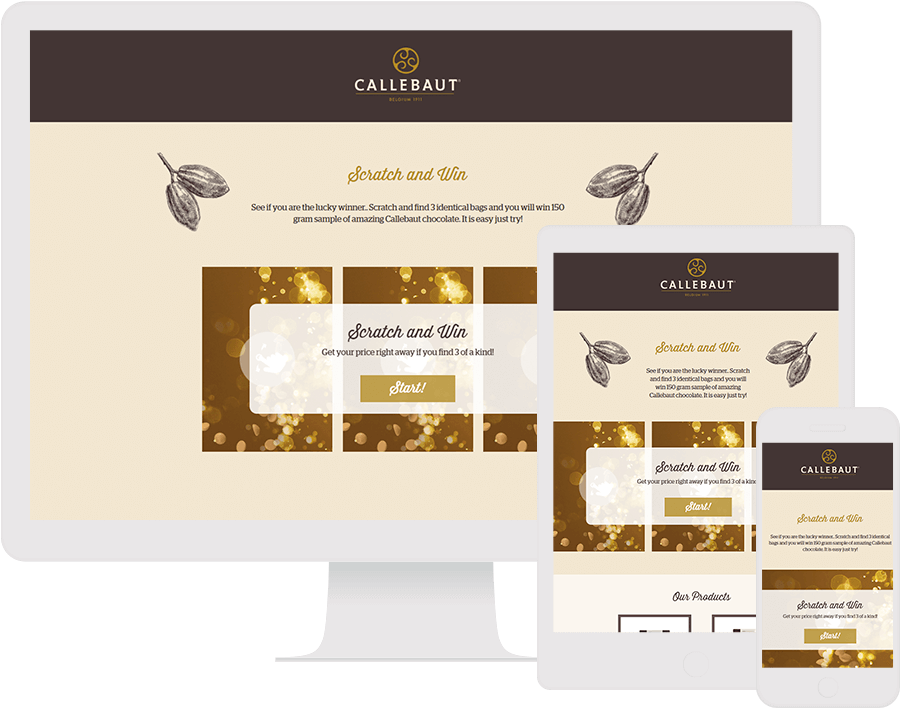
3. Magnetic North Travel
Magnetic North Travel created a fun Personality Test where people could win a trip to Yukon, Canada. They wanted to attract people interested in this destination, as they match their targeted audience. The test would ask participants what they would enjoy doing in Yukon. Based on their personal preferences, they would be assigned to one of the four possible outcomes. Before seeing the result and entering the competition, visitors were asked to sign up for their newsletter. That way, they succeeded in fulfilling their goal of generating new leads.
According to the Marketing Manager in charge of the project, Vanessa Sumpman, the campaign definitely exceeded all expectations!

4. The Perfume Shop
Before the royal wedding of Prince Harry and Meghan, The Perfume Shop created a Love Calculator to entertain their customers. Participants were invited to write their names and the name of their crush/partner to calculate their love score. Depending on the names, a percentage was given together with a personalized message and matching products. It was also possible to share the result with friends on Facebook.
Hannah Walsh, UX Design Manager at The Perfume Shop, thinks that Interactive Content is the perfect way for them to engage with their customers and it helps them achieve great results.

5. Pagely
Pagely created an Interactive Video in the form of an Interactive Sales Consultation. The interactive sales consultation was based on a series of questions, that would each branch out and provide personal messages based on the choices made throughout the video. Every interaction was tracked and connected with Active Campaign, to apply different segment tags based on the answers given. The purpose behind this project was to lower the barrier of entry and create new sales-ready leads by offering a self-serve virtual consultation as an option.
Sean Tierney, Director of Sales at Pagely, believes that it served them both to get them new leads they might not have acquired otherwise, as well as to provide them with a mechanism to deepen the rapport and engagement in a way that scales and doesn’t consume any overhead from the sales team.

Tools to create Interactive Content
There are two different types of tools: Interactive Content platforms and point solutions. With point solutions, you can only create one specific type of Interactive Content. However, one type is generally not enough! That’s why going with an Interactive Content platform is the best way to boost your success.
1. Dot.vu
Dot.vu is by far the most complete and specialized Interactive Content platform out there. There are over 350+ customizable templates on the MarketPlace. You can create all the different types of Interactive Experiences we introduced before and more. Also, the pricing adapts to your needs, so you can purchase templates individually or decide to go with a full membership. Finally, if you need a dedicated team to create your Interactive Experiences for you, they offer in-house agency services. They have also been selected as the winner of ‘Best Interactive Content Platform‘ in the 2024 Martech Breakthrough Awards. This win speaks for itself as they aim to help you transform the way you interact with your customers with fully-fledged Interactive Experiences.
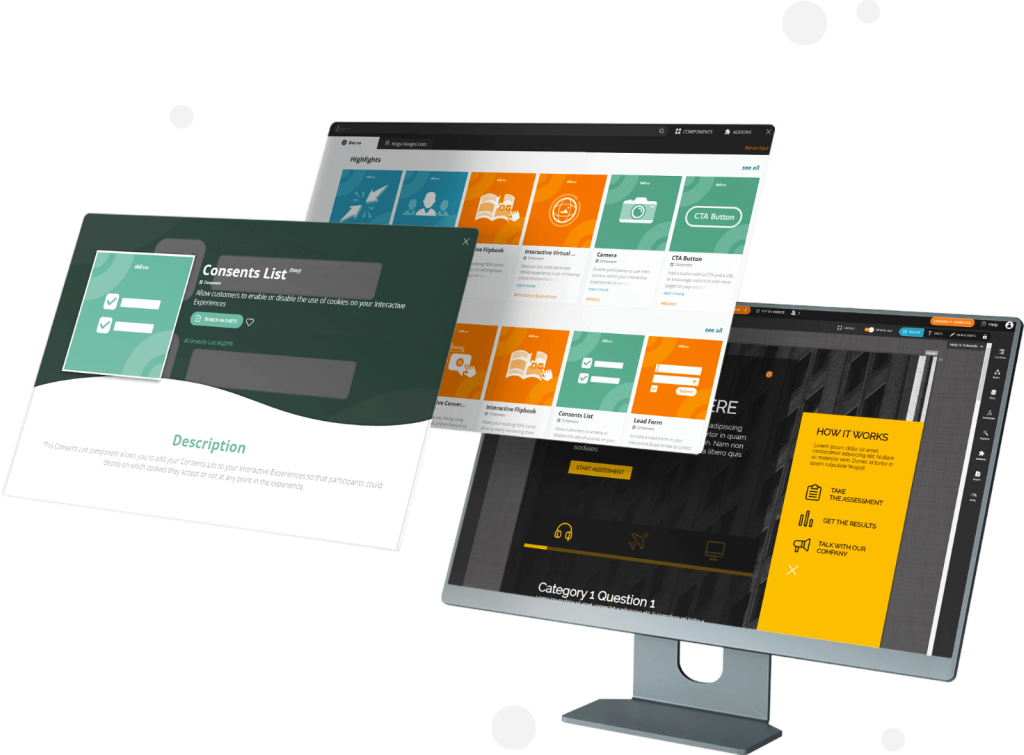
2. Rock Content
Rock Content is a company specializing in Content Marketing and diving into Interactive Content. They help brands launch high-quality content strategies to build awareness and drive revenue. On their platform, you can create Quizzes, Calculators, eBooks, Infographics, and so on.

3. Outgrow
Outgrow is similar to Dot.vu in the sense that they also allow you to create Interactive Experiences from many different templates. However, they offer fewer types of Interactive Experiences and are more specialized in Calculators, Quizzes, Assessments, Recommendations, Polls, Chatbots, GiveAways, and Surveys.

4. Ceros
Similar to Rock Content, Ceros works with everything related to Content Marketing. Their platform Ceros Studio can help you create Experiential Content. Ceros Studio is designed to help marketers and designers work together.

5. ThingLink
Thinglink is highly specialized in Interactive Media: Images, Videos, Virtual Tours, 3D Models, and simulations. They aim to help companies make online feel more real and explain complex ideas, products, or services with Interactive Visuals.

How to measure the success of your Interactive Experiences
Measuring the effectiveness of Interactive Content will highly depend on the types of Interactive Content and the goals of your Interactive Marketing Campaigns. Nonetheless, below we will present 5 Interactive Content metrics that are interesting to measure.
1. Views
Firstly, you’ll want to know how many users viewed your Interactive Experiences. It might also be interesting to know how you got these views. For example, how many views came from Facebook or how many views came from Google Ads. That way, you can improve the way you promote your Interactive Experiences.
2. Completion Rate
Another interesting thing to measure is how many people completed your Interactive Experience. This means how many people answered all the questions in your quiz or watch your Interactive Video to the end. You can calculate your completion rate by dividing the number of views by the number of completions.
Pro Tip: If your completion rate is low, you might want to re-think your Interactive Experience. Try to make it more engaging and work on the design.
3. Social Shares
For some types of Interactive Content, such as Social Interactive Content, your goal is to encourage Social Share. Then, it’s important to measure the effectiveness of your Interactive Content campaign by looking into how many visitors shared your Interactive Experience.
4. New Leads
You can also measure the effectiveness of some Interactive Experiences by looking at how many new leads you got from them. If you have many visitors but you are not getting many leads, try looking into gated content best practices.
5. Sales
Finally, for lots of Interactive Experiences, you’ll want to measure if your content leads to sales. This is particularly important for Guided Selling experiences such as Product Recommenders and Solution Builders.
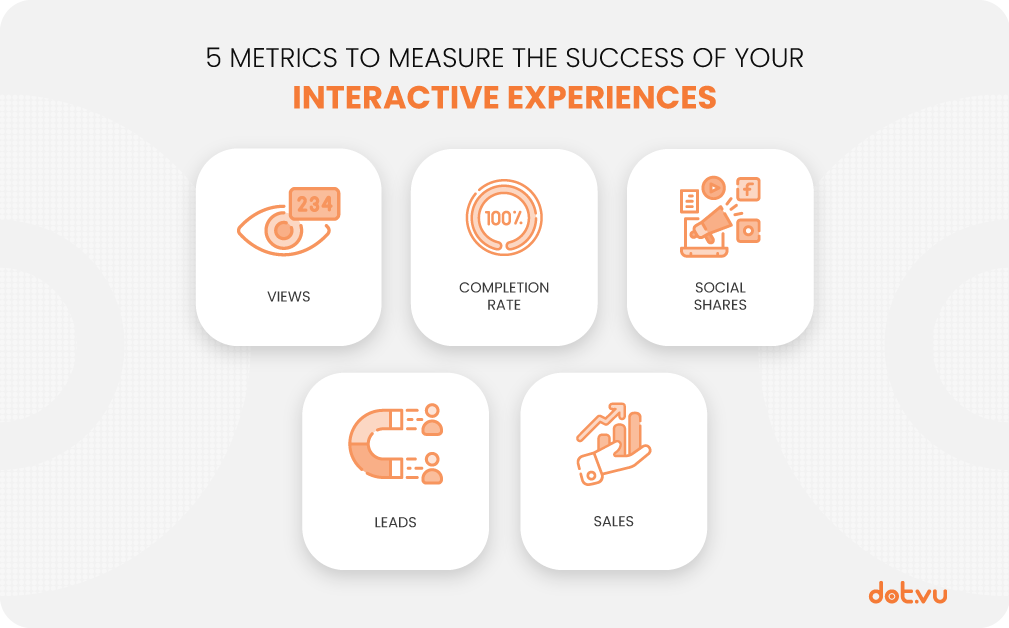
Ready to take the jump into Interactive Content?
To sum up, keep in mind that Interactive Content is the future of content marketing, as it engages your customers much more than static content. Moreover, integrating Interactive Content into your marketing strategy is important to better connect your brand with your customers, and stay ahead of your competition.
Are you ready to start creating your own Interactive Content? On the Dot.vu’s Interactive Content platform, you can find 250+ inspiring templates to get started with Interactive Content. Create a free account and start customizing!
